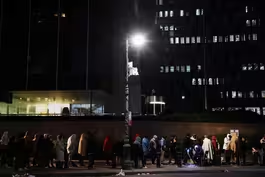
How airline passengers managed to survive fiery runway crash
Clip: 1/2/2024 | 8m 9sVideo has Closed Captions
How airline passengers managed to survive fiery runway collision in Japan
A fiery runway collision at a Tokyo airport stunned the world Tuesday with dramatic imagery. All of the airline passengers survived, but five crew members on a Coast Guard plane involved in the accident were killed. Neil Connery of Independent Television News reports, and Geoff Bennett discusses how passengers managed to make it out alive with aviation correspondent Miles O'Brien.
Problems playing video? | Closed Captioning Feedback
Problems playing video? | Closed Captioning Feedback
Major corporate funding for the PBS News Hour is provided by BDO, BNSF, Consumer Cellular, American Cruise Lines, and Raymond James. Funding for the PBS NewsHour Weekend is provided by...

How airline passengers managed to survive fiery runway crash
Clip: 1/2/2024 | 8m 9sVideo has Closed Captions
A fiery runway collision at a Tokyo airport stunned the world Tuesday with dramatic imagery. All of the airline passengers survived, but five crew members on a Coast Guard plane involved in the accident were killed. Neil Connery of Independent Television News reports, and Geoff Bennett discusses how passengers managed to make it out alive with aviation correspondent Miles O'Brien.
Problems playing video? | Closed Captioning Feedback
How to Watch PBS News Hour
PBS News Hour is available to stream on pbs.org and the free PBS App, available on iPhone, Apple TV, Android TV, Android smartphones, Amazon Fire TV, Amazon Fire Tablet, Roku, Samsung Smart TV, and Vizio.
Providing Support for PBS.org
Learn Moreabout PBS online sponsorshipwith dramatic imagery.
What's more stunning,# hundreds of passengers survived and managed to## get off safely.
But five crew members on a Coast# Guard plane involved in the accident were killed.
Neil Connery of Independent Television# News starts our coverage with this report.
NEIL CONNERY: Japan Airlines Flight# 516 bursts into flames as it lands## at Tokyo's Haneda Airport.
It collides with# a Japanese Coast Guard plane on touchdown.
Fire spreads along the Airbus# A350 carrying 379 people,## this the scene inside, panic as the flames# get nearer.
The pilot manages to keep control,## bringing the aircraft to a gradual halt, as smoke# begins to fill the cabin.
As cabin crew respond,## one child calls out: "Please# get me out of here quickly."
As fire envelops the fuselage, the 367# passengers and 12 crew start fleeing the## intense heat and smoke down emergency# shoots, with just moments to spare.
It's a miraculous escape.
With everyone now# off, fire crews battle flames so fierce they## burn through the plane's structure.
Five# people on board the Coast Guard aircraft,## which collided with the Airbus,# were killed.
Its pilot survived,## but suffered severe injuries.
It was taking aid# to victims of yesterday's powerful earthquake.
Japan's prime minister, Fumio Kishida, offered# his condolences to the five people killed,## who he said had lost their lives trying# to help others.
He also praised the Japan## Airlines crew and passengers for their# calmness.
Investigations are now getting## under way, as the remains of Japan# Airlines Flight 516 lie smoldering.
The 379 people who were on# board are overwhelmed with## relief they survived and walked away from this.
GEOFF BENNETT: Our own aviation# correspondent, Miles O'Brien, joins us now.
Miles, thank you for being with us.
So we know that the cr in this collision, but that the 379# passengers, including eight children## and the crew on board the commercial# plane, were successfully evacuated.
Tell us how they pulled that# off without further tragedy.
MILES O'BRIEN: Yes, Geoff, it is extraordinary.
And there's a lot of factors that come in technological story.
Some of it is crew training# and execution.
And, ultimately, it was the## passengers themselves who took it upon themselves# to act in a way that would save themselves.
Talking about the technology first, the aviation# industry has spent decades trying to make airplane## interiors less flammable, the upholstery and# the inner walls, et cetera.
That bought time.
The crew, the flight cabin crew in# particular, obviously did their job## well.
They're not really there to serve# us drinks and snacks.
They're there to## get us out in this instance of survivable crash.# They did they weren't pulling down their carry-on# bags.
They just did what they were told.
They turned around and they got out of that# plane, and they did it in under And it proved what a lot of us were not# so sure might happen in the real that it can happen that a plane# with upwards of 400 people on it## in flames can yield an accident where# no one gets hurt.
It's extraordinary.
GEOFF BENNETT: I want to ask# you more about the technology.
Tell us more about the design and the# manu A350.
How exactly did it buy them time?
Because# we saw how the cabin was engulfed in smoke,## and then after the passengers made it off, that# was when the plane was just enveloped by flames.
MILES O'BRIEN: Yes, there were -- years# ago, there were a series of accidents,## Geoff, that would have been otherwise# survivable were it not for the th at there was not much attention paid# to the flammability of the interior.
The FAA and other entities spent a lot of time# testing for alternatives.
The airline industry## responded, regulations changed, and that is a# significant piece of this story.
It really is## a matter of just providing a little bit of# time, and that's what -- all they needed.
The fact that, in 90 seconds,## upwards of 400 people could get out# seem GEOFF BENNETT: Japanese authorities say# there's going to be a full investigation.
Based on what you know right now, what factors# could have contributed to MILES O'BRIEN: Well, it's clear someone was in the# wrong here, whether it was air traffic control,## the crew of the A350 airliner,# or the Japanese Coast Guard crew.
We don't know.
But what is helpful in# this case is there will be, of course,## tape recordings of everybody and all the# air traffic control communications and the## onboard conversations, at least on the# Airbus A350.
And, of course, there are## people who are alive to testify in all three# locations.
So we will figure out what happened.
I think some of the factors they will# be looking at is this Coast Guard crew,## for example.
They were involved in trying to# get relief supplies to the Niigata region,## and subsequent to that earthquake and tsunami.# How fatigued were they?
Were they stressed?## Had they done multiple missions that day?# That's a factor they might want to look at.
When you look at the crew of the Airbus A350, was# there confusion about the clearances that were## given?
You have one controller on the tower# frequency talking to the landing aircraft,## another controller on the ground frequency talking## to the ground -- the aircraft that is# taxiing.
So conf So there's any number of ways that can -- this## can go awry.
And -- but I'm very# ce GEOFF BENNETT: And, lastly, Miles, are there any# takeaways here for the U.S. aviation industry?
MILES O'BRIEN: Well, officially, this is# not a U.S. accident.
These were -- this## was a French-made aircraft landing# in Japan with British-made engines.
So it's not as if the U.S. or its companies# will be a party to this investigation.
But,## as you and I have been talking about these past# months, there have been several near-misses in## the United States, for a lot of factors, including# a lack of staffing among air traffic controllers.
And there are other factors as well.# And whatever comes out of this,## I guarantee you will be in the category# of lessons learned for the entire aviation# industry.
When people say things# happen miraculously in aviation,## I don't believe that.
It's hard work and, frankly,# it's the hard lessons of incidents like this.
GEOFF BENNETT: Miles O'Brien,# thanks so much for joining us.
MILES O'BRIEN: You're welcome, Geoff.
Freed Israeli hostage: 'Stop the war and bring them home'
Video has Closed Captions
Clip: 1/2/2024 | 13m 29s | Freed Israeli hostage pleads with Netanyahu and Biden: 'Stop the war and bring them home' (13m 29s)
Harvard president resigns amid testimony controversy
Video has Closed Captions
Clip: 1/2/2024 | 5m 57s | Harvard president resigns amid controversy over antisemitism testimony, plagiarism claims (5m 57s)
NYC looks to amend right to shelter rule amid migrant surge
Video has Closed Captions
Clip: 1/2/2024 | 7m 22s | New York City looks to amend 'right to shelter' rule as it struggles to house migrants (7m 22s)
Tommy Prine on finding his voice in the shadow of his father
Video has Closed Captions
Clip: 1/2/2024 | 6m 40s | Singer-songwriter Tommy Prine on finding his own voice in the shadow of his famous father (6m 40s)
Why renting might be the favored choice in today's market
Video has Closed Captions
Clip: 1/2/2024 | 6m 6s | Why renting over buying might be the favored choice in today's real estate landscape (6m 6s)
Providing Support for PBS.org
Learn Moreabout PBS online sponsorship
- News and Public Affairs

FRONTLINE is investigative journalism that questions, explains and changes our world.

- News and Public Affairs

Amanpour and Company features conversations with leaders and decision makers.












Support for PBS provided by:
Major corporate funding for the PBS News Hour is provided by BDO, BNSF, Consumer Cellular, American Cruise Lines, and Raymond James. Funding for the PBS NewsHour Weekend is provided by...




